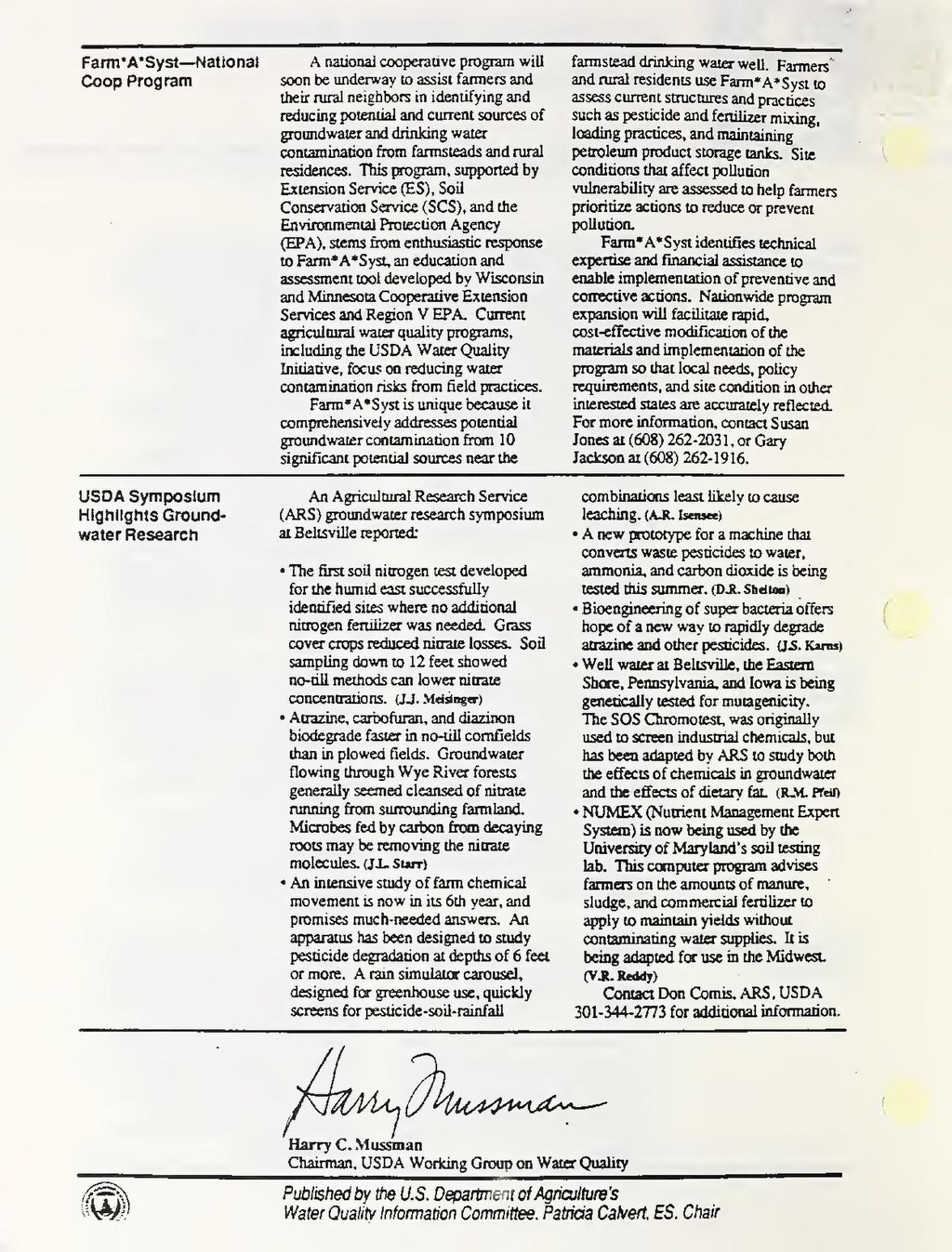- Farm*A*Syst—National Coop Program
A national cooperative program will soon be underway to assist farmers and their rural neighbors in identifying and reducing potential and current sources of groundwater and drinking water contamination from farmsteads and rural residences. This program, supported by Extension Service (ES), Soil Conservation Service (SCS), and the Environmental Protection Agency (EPA), stems from enthusiastic response to Farm*A*Syst, an education and assessment tool developed by Wisconsin and Minnesota Cooperative Extension Services Region V EPA. Current agricultural water quality programs, including the USDA Water Quality Initiative, focus on reducing water contamination risks from field practices.
Farm*A*Syst is unique because it comprehensively addresses potential groundwater contamination from 10 significant potential sources near the farmstead drinking water well. Farmers and rural residents use Farm*A*Syst to assess current structures and practices such as pesticide and fertilizer mixing, loading practices, and maintaining petroleum product storage tanks. Site conditions that affect pollution vulnerability are assessed to help farmers prioritize actions to reduce or prevent pollution.
Farm*A*Syst identifies technical expertise and financial assistance to enable implementation of preventive and corrective actions. Nationwide program expansion will facilitate rapid, cost-effective modification of the materials and implementation of the program so that local needs, policy requirements, and site condition in other interested states are accurately reflected. For more information, contact Susan Jones at (608) 262-2031, or Gary Jackson at (608) 262-1916.
- USDA Symposium Highlight Groundwater Research
An Agricultural Research Service (ARS) groundwater research symposium at Beltsville reported:
- The first soil nitrogen test developed for the humid east successfully identified sites where no additional nitrogen fertilizer was needed. Grass cover crops reduced nitrate losses. Soil sampling down to 12 feet showed no-till methods can lower nitrate concentrations. (J.J. Meisinger)
- Atrazine, carbofuran, and diazinon biodegrade faster in no-till cornfields than in plowed fields. Groundwater flowing through Wye River forests generally seemed cleansed of nitrate running from surrounding farmland. Microbes fed by carbon from decaying roots may be removing the nitrate molecules. (J.L. Starr)
- An intensive study of farm chemical movement is now in its 6th year, and promises much-needed answers. An apparatus has been designed to study pesticide degradation at depths of 6 feet or more. A rain simulator carousel, designed for greenhouse use, quickly screens for pesticide–soil–rainfall combinations least likely to cause leaching. (A.R. Isensee)
- A new prototype for a machine that converts waste pesticides to water, ammonia, and carbon dioxide is being tested this summer. (D.R. Shelton)
- Bioengineering of super bacteria offers hope of a new way to rapidly degrade atrazine and other pesticides. (J.S. Karns)
- Well water at Beltsville, the Eastern Shore, Pennsylvania, and Iowa is being genetically tested for mutagenicity. The SOS Chromotest, was originally used to screen industrial chemicals, but has been adapted by ARS to study both the effects of chemicals in groundwater and the effects of dietary fat. (R.M. Pfeif)
- NUMEX (Nutrient Management Expert System) is now being used by the University of Maryland’s soil testing lab. This computer program advises farmers on the amounts of manure, sludge, and commercial fertilizer to apply to maintain yields without contaminating water supplies. It is being adapted for use in the Midwest. (V.R. Reddy)
Contact Don Comis, ARS, USDA 301-344-2773 for additional information.
Harry C. Mussman
Chairman, USDA Working Group on Water Quality
Published by the U.S. Department of Agriculture’s
Water Quality Information Committee, Patricia Calvert, ES, Chair
